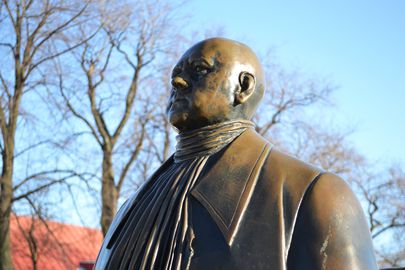

If we now continue on our way along the central avenue we come across a statue which continues to divide opinion among visitors and St Petersburgers alike. It's a statue of Peter the Great, presented as a gift to the city by contemporary Russian sculptor Mikhail Shemyakin. The statue was unveiled here in 1991 – the year in which the city's historical name of St Petersburg replaced the soviet-era version of 'Leningrad' – thanks to an initiative of the Mayor at that time, Anatoly Sobchak. (Mayor Sobchak's daughter Ksenia has become, by coincidence, not only a well-known TV presenter, but an open critic and leader of opinion against Vladimir Putin - who once served in her father's city administration). At the time it was only the third statue of Tsar Peter in the city (not counting various busts of the Tsar) – the other two being Falconet's monumental statue of Peter as 'The Bronze Horseman', and a statue made by Rastrelli at the Mikhailovsky Palace. But this particular statue differs in every particular from the other two, and radically so.
The first thing that strikes the eye are the disfigured proportions of the Tsar's bodily appearance – his gawping visage, bulging eyes and cat-like whiskers - so long that they look like distended fingers... and his feet in worn-out shoes. The Tsar is seen wearing common clothes, and sitting on a very dull chair, rather than any kind of throne. He has no orb or sceptre of power, nor does he even have his ceremonial wig on. It's interesting what emigré Russian sculptor Shemyakin wanted to say about the Tsar, in this work which he donated and shipped from the USA to Russia at his own expense?
However, it turns out that there is an extensive back-story to this statue, running back to the days of the Tsar himself. In 1719, six years before the Tsar's death, the sculptor and architect Rastrelli petitioned the Tsar to take a plaster cast of his face - so that it could be used for the statue of His Majesty to be installed at the Mikhailovsky Palace. The process of taking the cast was long and unpleasant – His Royal Highness was obliged to smear his face liberally with pork dripping fat and stuff breathing tubes up his nose, so that the thick plaster could be applied to his face – to get a perfect likeness. The resulting face cast was used not only in Rastrelli's statue for the Mikhailovsky Palace, but also as a death-mask - after the Tsar's demise - for his famous waxworks model of the great monarch. This figure of the Tsar, dressed in his full royal regalia and sitting in a comfortable armchair was displayed in Tsar Peter's Winter Palace. (The location of this first Winter Palace is now occupied by the Hermitage Theatre – the palace was destroyed by fire). Rastrelli took the precaution of fitting the waxwork with special hinges for the arms and legs, so that it could be positioned ideally in the armchair. Nowadays you can see this famous waxworks model in the Hermitage Museum, in the special display devoted to the original Winter Palace of Peter the Great's time. People nowadays have mostly seen waxworks before – but for people of Peter's time it was a truly horrifying experience to be confronted with a perfect likeness of the recently-deceased monarch.
And in fact it was this particular aspect of Rastrelli's work which intrigued Shemyakin. In reality has has scarcely altered the appearance of Rastrelli's plaster cast of the royal features. But he has grotesquely lengthened His Majesty's arms and legs, with the intention of rendering the royal personage absurd. By contrast with the heroic figure on Falconet's horse, or Rastrelli's valiant knight-in-armour, Shemyakin shows Peter not as a winner, but a loser. He has lost his battle with the elements, 'in defiance' of which he built his city here. To spite him, the elements have left him looking like a an unsuccessful scarecrow. He's lost his wager with history - and history has dragged him back to the scene of the crime, looking as he does here. Peter called St Petersburg 'his paradise', but we get a glimpse of that 'paradise' here. Shemyakin has depicted Peter as a walking corpse, and his paradise is a deadly sham.
Shemyakin's Tsar, bug-eyed & loony
With shrunken head and scarecrow's arm
Looked on his hands, so thin and puny
Amazed his shoes have come to harm?
“Where's my bronze? My flesh? What - dead?
Who's grave-robbed me by dead of night?”
But when saddled-up, with back-flung head,
He gallops past the Neva, in full flight!